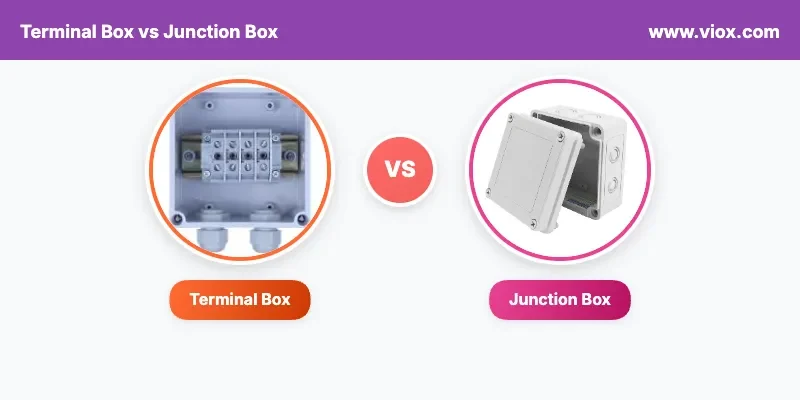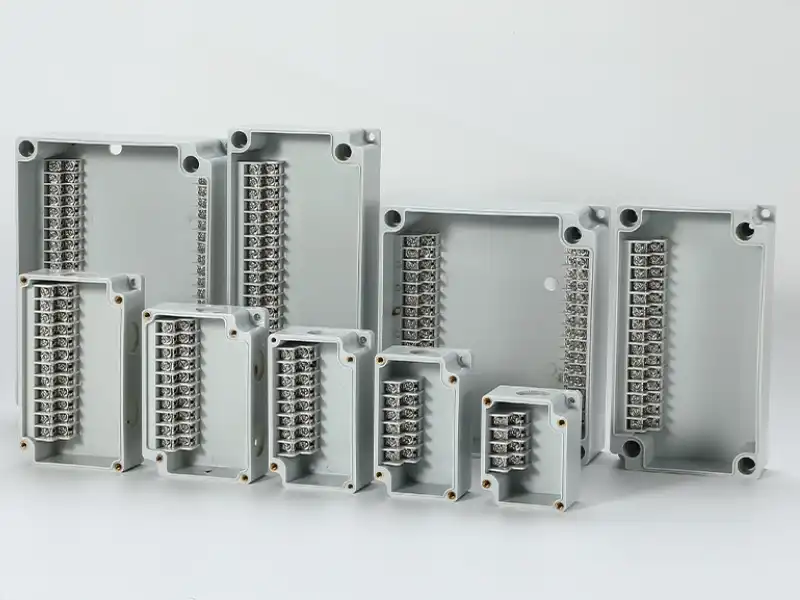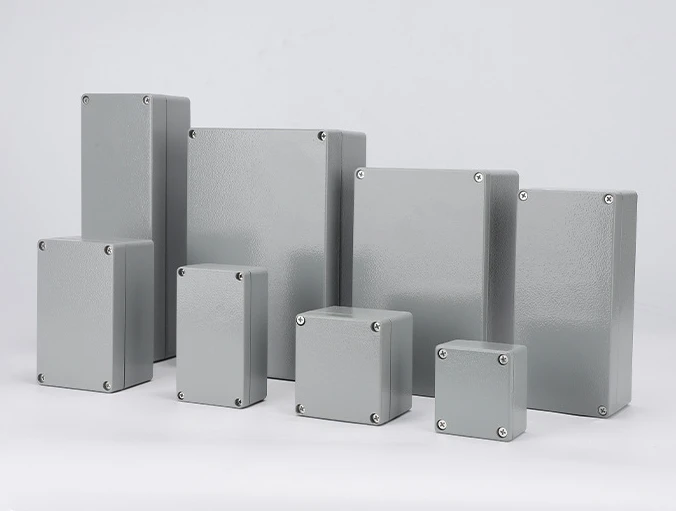ចម្លើយរហ័ស៖ ប្រអប់ស្ថានីយផ្ទុកការតភ្ជាប់អគ្គិសនីជាមួយនឹងស្ថានីយដែលអាចចូលដំណើរការបានសម្រាប់ភ្ជាប់ឧបករណ៍ ខណៈពេលដែលប្រអប់ប្រសព្វមានការភ្ជាប់ខ្សែនិងការតភ្ជាប់ដែលនៅតែបិទជារៀងរហូត។ ប្រអប់ស្ថានីយអនុញ្ញាតឱ្យចូលដំណើរការបានយ៉ាងងាយស្រួលសម្រាប់ការថែទាំនិងការតភ្ជាប់ឧបករណ៍ ខណៈពេលដែលប្រអប់ប្រសព្វការពារសន្លាក់ខ្សែអចិន្រ្តៃយ៍ហើយកម្រត្រូវបានបើកបន្ទាប់ពីការដំឡើង។.
ការយល់ដឹងពីភាពខុសគ្នារវាងប្រអប់ស្ថានីយនិងប្រអប់ប្រសព្វគឺមានសារៈសំខាន់សម្រាប់ការដំឡើងអគ្គិសនីប្រកបដោយសុវត្ថិភាព ការអនុលោមតាមកូដ និងការថែទាំប្រព័ន្ធប្រកបដោយប្រសិទ្ធភាព។ មគ្គុទ្ទេសក៍ដ៏ទូលំទូលាយនេះគ្របដណ្តប់អ្វីគ្រប់យ៉ាងដែលអ្នកត្រូវដឹងដើម្បីធ្វើការជ្រើសរើសត្រឹមត្រូវសម្រាប់គម្រោងអគ្គិសនីរបស់អ្នក។.
តើប្រអប់ស្ថានីយនិងប្រអប់ប្រសព្វជាអ្វី?
និយមន័យប្រអប់ស្ថានីយ
មួយ ប្រអប់ស្ថានីយ គឺជាប្រអប់ព័ទ្ធជុំវិញអគ្គិសនីដែលមានចំណុចតភ្ជាប់ដែលអាចចូលដំណើរការបាន (ស្ថានីយ) ដែលខ្សែអគ្គិសនីភ្ជាប់ទៅឧបករណ៍ គ្រឿងបរិក្ខារ ឬចំណុចចែកចាយ។ ប្រអប់ទាំងនេះត្រូវបានរចនាឡើងសម្រាប់ការចូលប្រើញឹកញាប់ ដែលអនុញ្ញាតឱ្យអ្នកជំនាញអគ្គិសនី និងអ្នកបច្ចេកទេសអាចភ្ជាប់ ផ្តាច់ ឬថែទាំការតភ្ជាប់អគ្គិសនីបានយ៉ាងងាយស្រួលដោយមិនរំខានដល់ខ្សែភ្លើងអចិន្រ្តៃយ៍។.
លក្ខណៈសំខាន់ៗនៃប្រអប់ស្ថានីយ៖
- មានប្លុកស្ថានីយដែលអាចចូលដំណើរការបាន ឬចំណុចតភ្ជាប់
- រចនាឡើងសម្រាប់ការចូលប្រើ និងថែទាំជាប្រចាំ
- ផ្ទុកការតភ្ជាប់រវាងខ្សែភ្លើងអចិន្រ្តៃយ៍ និងឧបករណ៍
- ជារឿយៗត្រូវបានប្រើសម្រាប់ប្រព័ន្ធគ្រប់គ្រង និងការតភ្ជាប់ឧបករណ៍
និយមន័យប្រអប់ប្រសព្វ
មួយ ប្រអប់ប្រសព្វ គឺជាប្រអប់ព័ទ្ធជុំវិញអគ្គិសនីដែលការពារការតភ្ជាប់ខ្សែអចិន្រ្តៃយ៍ ការភ្ជាប់ និងសន្លាក់ពីការខូចខាតបរិស្ថាន និងការប៉ះទង្គិចដោយចៃដន្យ។ ប្រអប់ទាំងនេះមានការតភ្ជាប់ដែលត្រូវបានធ្វើឡើងម្តងក្នុងកំឡុងពេលដំឡើង ហើយកម្រត្រូវការចូលប្រើនៅពេលក្រោយ។.
លក្ខណៈសំខាន់ៗនៃប្រអប់ប្រសព្វ៖
- ការពារការភ្ជាប់ខ្សែ និងការតភ្ជាប់អចិន្រ្តៃយ៍
- រចនាឡើងដើម្បីបិទជិតបន្ទាប់ពីការដំឡើង
- ផ្តោតលើសុវត្ថិភាព និងការការពារបរិស្ថាន
- តម្រូវដោយកូដអគ្គិសនីសម្រាប់ការតភ្ជាប់ខ្សែភាគច្រើន
ប្រអប់ស្ថានីយទល់នឹងប្រអប់ប្រសព្វ៖ ការប្រៀបធៀបពេញលេញ
| លក្ខណៈ | ប្រអប់ស្ថានីយ | សព្វប្រអប់ |
|---|---|---|
| គោលបំណងចម្បង | ចំណុចតភ្ជាប់ដែលអាចចូលដំណើរការបានសម្រាប់ឧបករណ៍ | ការការពារការតភ្ជាប់ខ្សែអចិន្រ្តៃយ៍ |
| ភាពញឹកញាប់នៃការចូលប្រើ | ការចូលប្រើជាប្រចាំសម្រាប់ការថែទាំ | កម្របើកបន្ទាប់ពីការដំឡើង |
| ប្រភេទការតភ្ជាប់ | ប្លុកស្ថានីយ ការតភ្ជាប់ដែលអាចដកចេញបាន | គ្រាប់ខ្សែ ការភ្ជាប់អចិន្រ្តៃយ៍ |
| ទីតាំងដំឡើង | បន្ទប់ឧបករណ៍ បន្ទះគ្រប់គ្រង | ពាសពេញប្រព័ន្ធអគ្គិសនី |
| តម្រូវការកូដ | ត្រូវតែបំពេញតាមស្តង់ដារលទ្ធភាពទទួលបាន | ត្រូវតែបំពេញតាមស្តង់ដារការពារ |
| តម្រូវការដាក់ស្លាក | ការកំណត់អត្តសញ្ញាណស្ថានីយលម្អិត | ការកំណត់អត្តសញ្ញាណសៀគ្វីមូលដ្ឋាន |
| ជួរទំហំ | ប្រែប្រួលអាស្រ័យលើសមត្ថភាពស្ថានីយ | ទំហំសម្រាប់ការពារបាច់ខ្សែ |
| កត្តាចំណាយ | ខ្ពស់ជាងដោយសារតែផ្នែករឹងស្ថានីយ | តម្លៃទាបសម្រាប់ការការពារជាមូលដ្ឋាន |
| ថែទាំ | តម្រូវឱ្យមានការដំឡើងដែលអាចចូលដំណើរការបាន | តម្រូវការថែទាំតិចតួចបំផុត |
| ការផ្តោតអារម្មណ៍លើសុវត្ថិភាព | ងាយស្រួលចូលប្រើជាមួយនឹងការការពារត្រឹមត្រូវ | ការការពារអតិបរមាពីការប៉ះពាល់ |
ភាពខុសគ្នាដ៏សំខាន់រវាងប្រអប់ស្ថានីយ និងប្រអប់ប្រសព្វ
លទ្ធភាពទទួលបានការតភ្ជាប់
ប្រអប់ស្ថានីយ មានលក្ខណៈពិសេសនៃការតភ្ជាប់ដែលអាចដកចេញបានដែលត្រូវបានរចនាឡើងសម្រាប់ភាពងាយស្រួលក្នុងការចូលប្រើ។ អ្នកអាចផ្តាច់ឧបករណ៍បានយ៉ាងឆាប់រហ័ស សាកល្បង សៀគ្វី, ឬជំនួសឧបករណ៍ដោយមិនរំខានដល់ហេដ្ឋារចនាសម្ព័ន្ធខ្សែភ្លើងអចិន្រ្តៃយ៍។ ប្លុកស្ថានីយអនុញ្ញាតឱ្យមានការតភ្ជាប់ដែលបានរៀបចំ និងដាក់ស្លាកដែលអ្នកបច្ចេកទេសអាចកំណត់ និងកែប្រែដោយសុវត្ថិភាព។.
ប្រអប់ប្រសព្វ មានការតភ្ជាប់អចិន្រ្តៃយ៍ដែលអ្នកជំនាញអគ្គិសនីធ្វើឡើងកំឡុងពេលដំឡើងដំបូង។ ការតភ្ជាប់ទាំងនេះប្រើគ្រាប់ខ្សែ ឧបករណ៍ភ្ជាប់ crimp ឬវិធីសាស្ត្រភ្ជាប់អចិន្រ្តៃយ៍ផ្សេងទៀតដែលបង្កើតចំណងដែលមានសុវត្ថិភាព និងប្រើប្រាស់បានយូររវាង conductors ។.
តម្រូវការដំឡើង
ប្រអប់ស្ថានីយ ត្រូវតែត្រូវបានដំឡើងនៅទីតាំងដែលអាចចូលដំណើរការបានដែលអ្នកបច្ចេកទេសអាចទៅដល់ដោយសុវត្ថិភាពសម្រាប់ការថែទាំ។ មាត្រា 314 នៃក្រមអគ្គិសនីជាតិ (NEC) តម្រូវឱ្យមានកន្លែងធ្វើការគ្រប់គ្រាន់នៅជុំវិញប្រអប់ព័ទ្ធជុំវិញទាំងនេះ។ ពួកវាច្រើនតែត្រូវការការដំឡើងនៅកម្ពស់ងាយស្រួលជាមួយនឹងភ្លើងបំភ្លឺត្រឹមត្រូវ និងផ្លូវច្បាស់លាស់។.
ប្រអប់ប្រសព្វ អាចត្រូវបានដំឡើងនៅទីតាំងដែលមិនសូវងាយស្រួលចូលប្រើ រួមទាំងខាងលើពិដាន ខាងក្រោយជញ្ជាំង ឬក្នុងកន្លែងវារ 只要ពួកវាអាចចូលដំណើរការបានសម្រាប់ការត្រួតពិនិត្យ។ ទោះជាយ៉ាងណាក៏ដោយ ប្រអប់ប្រសព្វដែលមិនអាចចូលដំណើរការបានទាំងស្រុងត្រូវបានហាមឃាត់ដោយក្រមអគ្គិសនីភាគច្រើន។.
ការវាយតម្លៃការការពារបរិស្ថាន
ប្រភេទប្រអប់ទាំងពីរត្រូវតែបំពេញតាមការវាយតម្លៃ NEMA (សមាគមអ្នកផលិតអគ្គិសនីជាតិ) ដែលសមស្របសម្រាប់បរិស្ថានដំឡើងរបស់ពួកគេ៖
- ទីតាំងស្ងួតក្នុងផ្ទះ៖ NEMA 1 ឬ 12
- កម្មវិធីក្រៅផ្ទះ៖ NEMA 3R ឬ 4
- ទីតាំងគ្រោះថ្នាក់៖ NEMA 7 ឬ 9
- បរិស្ថានដែលច្រេះ៖ NEMA 4X
ប្រអប់ស្ថានីយច្រើនតែត្រូវការការវាយតម្លៃការពារខ្ពស់ជាងមុន ដោយសារតែការចូលប្រើញឹកញាប់ និងការតភ្ជាប់ស្ថានីយដែលងាយរងគ្រោះរបស់វា។.
កម្មវិធី និងករណីប្រើប្រាស់
ពេលណាត្រូវប្រើប្រអប់ស្ថានីយ
កម្មវិធីប្រព័ន្ធគ្រប់គ្រង៖
- មជ្ឈមណ្ឌលគ្រប់គ្រងម៉ូទ័រសម្រាប់ឧបករណ៍ឧស្សាហកម្ម
- បន្ទះគ្រប់គ្រងប្រព័ន្ធ HVAC
- ការតភ្ជាប់ស្វ័យប្រវត្តិកម្មអគារ
- ចំណុចប្រទាក់ប្រព័ន្ធជូនដំណឹងអំពីអគ្គីភ័យ
ចំណុចតភ្ជាប់ឧបករណ៍៖
- ការតភ្ជាប់ចំណីបន្ទះអគ្គិសនី
- ប្រអប់តភ្ជាប់ម៉ូទ័រ និងស្នប់
- ចំណុចប្រទាក់ប្រព័ន្ធគ្រប់គ្រងពន្លឺ
- ការបញ្ចប់ឧបករណ៍ទំនាក់ទំនង
ការដំឡើងដែលសំខាន់សម្រាប់ការថែទាំ៖
- មន្ទីរពេទ្យ និងមណ្ឌលថែទាំសុខភាព
- មជ្ឈមណ្ឌលទិន្នន័យ និងបន្ទប់ម៉ាស៊ីនមេ
- ឧបករណ៍ដំណើរការផលិត
- ប្រព័ន្ធបម្រុងទុកបន្ទាន់
ពេលណាត្រូវប្រើប្រអប់ប្រសព្វ
ការតភ្ជាប់ខ្សែភ្លើងអចិន្ត្រៃយ៍៖
- ការភ្ជាប់សៀគ្វីរងនៅក្នុងផ្ទះលំនៅដ្ឋាន
- ចំណុចចែកចាយចំណីនៅក្នុងអគារពាណិជ្ជកម្ម
- ការតភ្ជាប់សៀគ្វីភ្លើងបំភ្លឺនៅទូទាំងបរិក្ខារ
- ការតភ្ជាប់ប្រអប់ព្រីភ្លើង និងកុងតាក់
កម្មវិធីការពារ៖
- ការផ្លាស់ប្តូរខ្សែភ្លើងក្រោមដី
- ការតភ្ជាប់ភ្លើងបំភ្លឺខាងក្រៅ
- ប្រព័ន្ធអគ្គិសនីអាងហែលទឹក និងស្ប៉ា
- ការដំឡើងអគ្គិសនីទីតាំងសើម
ការដំឡើងដែលតម្រូវដោយកូដ៖
- ទីតាំងណាមួយដែលខ្សែភ្លើងត្រូវបានភ្ជាប់ ឬតភ្ជាប់
- ការផ្លាស់ប្តូរវិធីសាស្ត្រខ្សែភ្លើង ឬប្រភេទខ្សែកាប
- ការការពារបរិស្ថានសម្រាប់ការតភ្ជាប់អគ្គិសនី
- ចំណុចម៉ោនឧបករណ៍សម្រាប់កុងតាក់ និងព្រីភ្លើង
លក្ខណៈវិនិច្ឆ័យនៃការជ្រើសរើស៖ របៀបជ្រើសរើសប្រអប់ដែលត្រឹមត្រូវ
វាយតម្លៃតម្រូវការតភ្ជាប់របស់អ្នក
ជ្រើសរើសប្រអប់ស្ថានីយនៅពេល៖
- អ្នកត្រូវការចូលប្រើការតភ្ជាប់ញឹកញាប់
- ឧបករណ៍ត្រូវការការថែទាំជាប្រចាំ
- ឧបករណ៍ច្រើនភ្ជាប់ទៅចំណុចតែមួយ
- ប្រព័ន្ធគ្រប់គ្រងត្រូវការចំណុចបញ្ចប់ដែលបានរៀបចំ
- ការចូលប្រើការដោះស្រាយបញ្ហាគឺមានសារៈសំខាន់
ជ្រើសរើសប្រអប់ប្រសព្វនៅពេល៖
- ធ្វើការភ្ជាប់ខ្សែភ្លើងអចិន្ត្រៃយ៍
- ការពារការតភ្ជាប់ពីបរិស្ថាន
- កូដតម្រូវឱ្យមានការតភ្ជាប់ដែលបានបិទជិត
- ទីតាំងដំឡើងមានតម្រូវការចូលប្រើមានកម្រិត
- ប្រសិទ្ធភាពតម្លៃគឺជាការព្រួយបារម្ភចម្បង
ពិចារណាលើបរិស្ថានដំឡើង
ការដំឡើងក្នុងផ្ទះ អាចប្រើប្រអប់ NEMA 1 ស្តង់ដារសម្រាប់ប្រភេទប្រអប់ទាំងពីរ ប៉ុន្តែប្រអប់ស្ថានីយអាចត្រូវការខ្យល់ចេញចូលបន្ថែមសម្រាប់ការសាយភាយកំដៅពីស្ថានីយ និងការតភ្ជាប់។.
ការដំឡើងនៅខាងក្រៅ តម្រូវឱ្យមានប្រអប់ការពារអាកាសធាតុ (NEMA 3R អប្បបរមា) ជាមួយនឹងប្រដាប់ផ្សាភ្ជាប់ និងប្រព័ន្ធបង្ហូរទឹកត្រឹមត្រូវ។ ប្រអប់ស្ថានីយត្រូវការការការពារបន្ថែមដោយសារតែតម្រូវការចូលប្រើរបស់វា។.
Hazardous locations (ទីតាំងគ្រោះថ្នាក់) តម្រូវឱ្យមានប្រអប់ការពារការផ្ទុះ ឬសុវត្ថិភាពដោយធម្មជាតិ ជាមួយនឹងការវាយតម្លៃការអនុម័តជាក់លាក់សម្រាប់ការចាត់ថ្នាក់គ្រោះថ្នាក់។.
វាយតម្លៃតម្រូវការថែទាំ
គណនាថ្លៃដើមសរុបនៃភាពជាម្ចាស់ រួមទាំងការដំឡើង ការចូលប្រើការថែទាំ និងភាពជឿជាក់រយៈពេលវែង។ ប្រអប់ស្ថានីយមានតម្លៃថ្លៃជាងដំបូង ប៉ុន្តែអាចកាត់បន្ថយពេលវេលាថែទាំ និងពេលវេលារងចាំរបស់ប្រព័ន្ធយ៉ាងសំខាន់។.
ការដំឡើង ការអនុវត្តល្អបំផុត
ការដំឡើងប្រអប់ស្ថានីយ
តម្រូវការទីតាំង៖
- ម៉ោននៅកម្ពស់ដែលអាចចូលដំណើរការបាន (ជាធម្មតា 4-6 ហ្វីតពីលើកម្រាលឥដ្ឋ)
- ផ្តល់កន្លែងធ្វើការគ្រប់គ្រាន់ យោងតាមមាត្រា 110.26 នៃ NEC
- ធានាបាននូវពន្លឺត្រឹមត្រូវ និងផ្លូវចូលដំណើរការច្បាស់លាស់
- ពិចារណាលើការពង្រីកនាពេលអនាគត និងតម្រូវការថែទាំ
លក្ខណៈបច្ចេកទេសនៃការម៉ោន៖
- ប្រើឧបករណ៍ម៉ោនដែលសមស្របសម្រាប់ប្រភេទជញ្ជាំង
- ធានាការដំឡើងកម្រិតសម្រាប់ការដំណើរការទ្វារត្រឹមត្រូវ
- រក្សាគម្លាតត្រឹមត្រូវពីឧបករណ៍ផ្សេងទៀត
- ធានាសុវត្ថិភាពសមាសធាតុខាងក្នុងទាំងអស់ប្រឆាំងនឹងរំញ័រ
ការអនុវត្តល្អបំផុតនៃការតភ្ជាប់៖
- សម្គាល់ស្ថានីយទាំងអស់ឱ្យបានច្បាស់លាស់ និងជាអចិន្ត្រៃយ៍
- ប្រើលក្ខណៈបច្ចេកទេសកម្លាំងបង្វិលត្រឹមត្រូវសម្រាប់ការតភ្ជាប់ស្ថានីយ
- អនុវត្តប្រព័ន្ធកូដពណ៌សម្រាប់សៀគ្វីផ្សេងៗគ្នា
- កត់ត្រាការតភ្ជាប់ទាំងអស់នៅក្នុងគំនូរដែលបានសាងសង់
ការដំឡើងប្រអប់ប្រសព្វ
តម្រូវការអនុលោមតាមច្បាប់៖
- រក្សាភាពងាយស្រួលក្នុងការចូលទៅដល់ យោងតាម NEC Article 314.29
- ផ្តល់ការគណនាបំពេញប្រអប់ឱ្យបានត្រឹមត្រូវ យោងតាម NEC Article 314.16
- ធានាទំហំប្រអប់គ្រប់គ្រាន់សម្រាប់វិធីសាស្ត្រតភ្ជាប់
- ដំឡើងការតភ្ជាប់ដី និងការភ្ជាប់សមស្រប
ស្តង់ដារការពារ:
- ជ្រើសរើសកម្រិត NEMA ដែលសមស្របសម្រាប់បរិស្ថាន
- ដំឡើងប្រដាប់ស្ទង់ និងប្រព័ន្ធផ្សាភ្ជាប់ឱ្យបានត្រឹមត្រូវ
- ផ្តល់លូបង្ហូរទឹកគ្រប់គ្រាន់សម្រាប់ការដំឡើងនៅខាងក្រៅ
- អនុវត្តការការពារច្រេះនៅក្នុងបរិស្ថានដែលធ្ងន់ធ្ងរ
គុណភាពនៃការតភ្ជាប់:
- ប្រើវិធីសាស្ត្រភ្ជាប់ដែលបានអនុម័ត (គ្រាប់ខ្សែ, ឧបករណ៍ភ្ជាប់ crimp)
- ធានាប្រវែងខ្សែដែលបានដកត្រឹមត្រូវ និងអ៊ីសូឡង់
- សាកល្បងការតភ្ជាប់ទាំងអស់ មុនពេលបិទប្រអប់
- លាបសមាសធាតុប្រឆាំងអុកស៊ីតកម្មដែលសមស្របសម្រាប់ conductors អាលុយមីញ៉ូម
ការពិចារណាអំពីសុវត្ថិភាព និងតម្រូវការកូដ
⚠️ ការព្រមានសុវត្ថិភាពសំខាន់
ការងារអគ្គិសនីទាំងអស់ត្រូវតែអនុលោមតាមក្រមអគ្គិសនីក្នុងស្រុក ហើយគួរតែត្រូវបានអនុវត្តដោយអ្នកជំនាញអគ្គិសនីដែលមានលក្ខណៈសម្បត្តិគ្រប់គ្រាន់។ ការដំឡើងមិនត្រឹមត្រូវអាចបណ្តាលឱ្យមានអគ្គីភ័យ ការឆក់ ឬគ្រោះថ្នាក់ដល់អាយុជីវិត។.
តម្រូវការនៃក្រមអគ្គិសនីជាតិ (គ.ជ.ប)
Article 314 – ប្រអប់ព្រីភ្លើង ឧបករណ៍ ទាញ និងប្រអប់ប្រសព្វ:
- ប្រអប់ទាំងអស់ត្រូវតែអាចចូលទៅដល់បានសម្រាប់ការត្រួតពិនិត្យ និងថែទាំ
- ការគណនាបំពេញប្រអប់មិនត្រូវលើសពីសមត្ថភាព 75% ទេ។
- ការដាក់ដី និងការភ្ជាប់ត្រឹមត្រូវត្រូវបានទាមទារសម្រាប់ប្រអប់ដែកទាំងអស់
- តម្រូវការទំហំធ្វើការអប្បបរមាត្រូវតែរក្សា
Article 110 – តម្រូវការទូទៅ:
- ការបោសសំអាតកន្លែងធ្វើការជុំវិញឧបករណ៍អគ្គិសនី
- ភាពសមស្របនៃបរិស្ថានសម្រាប់ទីតាំងដំឡើង
- តម្រូវការកំណត់អត្តសញ្ញាណ និងដាក់ស្លាកត្រឹមត្រូវ
- ស្តង់ដារដំឡើង និងត្រួតពិនិត្យប្រកបដោយវិជ្ជាជីវៈ
បំរែបំរួលកូដក្នុងស្រុក
យុត្តាធិការជាច្រើនមានតម្រូវការជាក់លាក់លើសពី NEC:
- តម្រូវការអាជ្ញាប័ណ្ណ និងការត្រួតពិនិត្យសម្រាប់ការងារអគ្គិសនី
- ប្រភេទប្រអប់ជាក់លាក់ដែលត្រូវបានអនុម័តសម្រាប់លក្ខខណ្ឌក្នុងស្រុក
- តម្រូវការសុវត្ថិភាពបន្ថែមសម្រាប់កម្មវិធីមួយចំនួន
- តម្រូវការអាជ្ញាប័ណ្ណវិជ្ជាជីវៈសម្រាប់អ្នកដំឡើង
ការដោះស្រាយបញ្ហាទូទៅ
បញ្ហាប្រអប់ស្ថានីយ
រលុងរតភ្ជាប់៖
- រោគសញ្ញា៖ ប្រតិបត្តិការមិនទៀងទាត់ កំដៅ ការឆាបឆេះ
- ដំណោះស្រាយ៖ ការត្រួតពិនិត្យកម្លាំងបង្វិលជុំជាប្រចាំ និងការត្រួតពិនិត្យកម្ដៅ
- ការការពារ៖ ប្រើស្ថានីយផ្ទុកដោយស្ព្រីង និងការថែទាំតាមកាលកំណត់
បញ្ហា corrosion:
- រោគសញ្ញា៖ ភាពធន់ខ្ពស់ ការតភ្ជាប់ខ្សោយ
- ដំណោះស្រាយ៖ សម្អាតទំនាក់ទំនង និងអនុវត្តសមាសធាតុប្រឆាំងអុកស៊ីតកម្ម
- ការការពារ៖ ប្រើកម្រិត NEMA និងខ្យល់ចេញចូលដែលសមស្រប
ភាពលំបាកក្នុងការចូលប្រើ:
- រោគសញ្ញា៖ ការពន្យាពេលថែទាំ គ្រោះថ្នាក់សុវត្ថិភាព
- ដំណោះស្រាយ៖ ផ្លាស់ទីទីតាំង ឬកែប្រែការម៉ោនសម្រាប់ការចូលប្រើកាន់តែប្រសើរ
- ការការពារ៖ រៀបចំផែនការដំឡើងដោយគិតគូរពីតម្រូវការថែទាំ
បញ្ហាប្រអប់ប្រសព្វ
ការជ្រាបចូលសំណើម:
- រោគសញ្ញា៖ ច្រេះ ការបំបែកអ៊ីសូឡង់ កំហុសដី
- ដំណោះស្រាយ៖ កែលម្អប្រព័ន្ធផ្សាភ្ជាប់ និងលូបង្ហូរទឹក
- ការការពារ៖ ប្រើប្រដាប់ស្ទង់ត្រឹមត្រូវ និងការដំឡើងការពារអាកាសធាតុ
ការចង្អៀត:
- រោគសញ្ញា៖ ការតភ្ជាប់ពិបាក ការរំលោភលើកូដ កំដៅ
- ដំណោះស្រាយ៖ ដំឡើងប្រអប់ធំជាង ឬចំណុចប្រសព្វបន្ថែម
- ការការពារ៖ គណនាការបំពេញប្រអប់ឱ្យបានត្រឹមត្រូវកំឡុងពេលរចនា
ការដំឡើងដែលមិនអាចចូលដំណើរការបាន:
- រោគសញ្ញា៖ ការរំលោភលើកូដ ការបរាជ័យក្នុងការត្រួតពិនិត្យ
- ដំណោះស្រាយ៖ ផ្តល់ការចូលប្រើជាអចិន្ត្រៃយ៍ ឬផ្លាស់ទីទីតាំងការតភ្ជាប់
- ការការពារ៖ ផ្ទៀងផ្ទាត់តម្រូវការភាពងាយស្រួល មុនពេលដំឡើង
គន្លឹះអ្នកជំនាញសម្រាប់ការដំឡើងប្រកបដោយវិជ្ជាជីវៈ
💡 ការណែនាំប្រកបដោយវិជ្ជាជីវៈ
សម្រាប់ប្រអប់ស្ថានីយ:
- តែងតែប្រើប្លុកស្ថានីយដែលបានវាយតម្លៃសម្រាប់វ៉ុល និងចរន្តសៀគ្វី
- អនុវត្តប្រព័ន្ធលេខ និងស្លាកដែលស៊ីសង្វាក់គ្នា
- រៀបចំផែនការសម្រាប់សមត្ថភាពស្ថានីយទំនេរ 25% សម្រាប់ការធ្វើឱ្យប្រសើរឡើងនាពេលអនាគត
- ប្រើបន្ទះរបាំងដើម្បីបំបែកកម្រិតវ៉ុលផ្សេងគ្នា
- កត់ត្រាការចាត់តាំងស្ថានីយទាំងអស់នៅក្នុងកំណត់ត្រាអចិន្ត្រៃយ៍
សម្រាប់ប្រអប់ប្រសព្វ៖
- ប្រអប់ទំហំសម្រាប់ការតភ្ជាប់ចរន្តអគ្គិសនី បូករួមទាំងសមត្ថភាពទំនេរ 25%
- ប្រើគ្រាប់ខ្សែដែលមានគុណភាព ឬឧបករណ៍ភ្ជាប់ខ្សែដែលបានអនុម័ត
- លាបកាសែតអគ្គិសនីលើការតភ្ជាប់គ្រាប់ខ្សែ សម្រាប់សុវត្ថិភាពបន្ថែម
- សម្គាល់សៀគ្វីទាំងអស់ឱ្យបានច្បាស់លាស់ ជាមួយនឹងស្លាកសញ្ញាអចិន្ត្រៃយ៍
- ធ្វើតេស្តការតភ្ជាប់ទាំងអស់ ជាមួយនឹងឧបករណ៍ត្រឹមត្រូវ មុនពេលបញ្ចេញថាមពល
ការអនុវត្តល្អបំផុតជាសកល៖
- ត្រូវបិទថាមពលជានិច្ច ហើយផ្ទៀងផ្ទាត់ជាមួយនឹងឧបករណ៍ធ្វើតេស្តត្រឹមត្រូវ
- ប្រើឧបករណ៍ការពារផ្ទាល់ខ្លួន (PPE) ដែលសមស្រប
- អនុវត្តតាមការណែនាំអំពីការដំឡើងរបស់អ្នកផលិតឱ្យបានត្រឹមត្រូវ
- រក្សាឯកសារលម្អិតនៃការងារអគ្គិសនីទាំងអស់
- កំណត់ពេលកម្មវិធីត្រួតពិនិត្យ និងថែទាំជាប្រចាំ
ការណែនាំរហ័ស
Selection Checklist
ជ្រើសរើសប្រអប់ស្ថានីយ ប្រសិនបើ៖
- ✅ ត្រូវការចូលប្រើជាញឹកញាប់សម្រាប់ការថែទាំ
- ✅ ឧបករណ៍ច្រើនភ្ជាប់នៅចំណុចតែមួយ
- ✅ តម្រូវឱ្យមានការបញ្ចប់ប្រព័ន្ធគ្រប់គ្រង
- ✅ អាទិភាពគឺការដោះស្រាយបញ្ហាបានយ៉ាងងាយស្រួល
- ✅ ឧបករណ៍ត្រូវការសេវាកម្មជាប្រចាំ
ជ្រើសរើសប្រអប់ប្រសព្វ ប្រសិនបើ៖
- ✅ ត្រូវការភ្ជាប់ខ្សែអចិន្ត្រៃយ៍
- ✅ ការការពារបរិស្ថានគឺជាកង្វល់ចម្បង
- ✅ ប្រសិទ្ធភាពតម្លៃគឺសំខាន់
- ✅ ការចូលប្រើកម្រ អាចទទួលយកបាន
- ✅ លេខកូដតម្រូវឱ្យមានការតភ្ជាប់ដែលបានបិទជិត
ព័ត៌មានទំនាក់ទំនងពេលមានអាសន្ន
សម្រាប់ការដំឡើងអគ្គិសនីស្មុគស្មាញ ឬការជួសជុលបន្ទាន់ ត្រូវពិគ្រោះជាមួយ៖
- អ្នកម៉ៅការអគ្គិសនីដែលមានអាជ្ញាប័ណ្ណ
- អធិការអគ្គិសនីក្នុងតំបន់
- ជំនួយបច្ចេកទេសរបស់អ្នកផលិតឧបករណ៍
- អ្នកប្រឹក្សាយោបល់ផ្នែកវិស្វកម្មជំនាញ
ជាញឹកញាប់បានសួរសំណួរ
តើអ្វីធ្វើឱ្យប្រអប់ស្ថានីយខុសពីប្រអប់ប្រសព្វទាក់ទងនឹងលទ្ធភាពចូលប្រើ?
ប្រអប់ស្ថានីយត្រូវបានរចនាឡើងជាពិសេសសម្រាប់ការចូលប្រើ និងថែទាំជាប្រចាំ ដោយមានការតភ្ជាប់ស្ថានីយដែលអាចដកចេញបាន ដែលអនុញ្ញាតឱ្យអ្នកបច្ចេកទេសភ្ជាប់ ឬផ្តាច់ឧបករណ៍បានយ៉ាងងាយស្រួល ដោយមិនរំខានដល់ខ្សែភ្លើងអចិន្ត្រៃយ៍។ ប្រអប់ប្រសព្វមានការតភ្ជាប់អចិន្ត្រៃយ៍ដែលត្រូវបានធ្វើឡើងម្តងក្នុងអំឡុងពេលដំឡើង ហើយកម្រត្រូវការចូលប្រើ ដោយផ្តោតលើការការពារជាជាងលទ្ធភាពចូលប្រើ។.
តើអ្នកអាចប្រើប្រអប់ប្រសព្វជាប្រអប់ស្ថានីយសម្រាប់ការតភ្ជាប់ឧបករណ៍បានទេ?
ខណៈពេលដែលអាចធ្វើទៅបានតាមបច្ចេកទេស វាមិនត្រូវបានណែនាំទេ។ ប្រអប់ប្រសព្វខ្វះប្លុកស្ថានីយដែលបានរៀបចំ និងចំណុចតភ្ជាប់ដែលអាចចូលដំណើរការបាន ដែលធ្វើឱ្យប្រអប់ស្ថានីយល្អសម្រាប់ការតភ្ជាប់ឧបករណ៍។ ការប្រើប្រាស់ប្រភេទប្រអប់ខុស អាចបង្កើតការលំបាកក្នុងការថែទាំ ហើយប្រហែលជាមិនបំពេញតាមតម្រូវការនៃការចូលប្រើសម្រាប់កម្មវិធីមួយចំនួន។.
តើមានតម្រូវការលេខកូដអ្វីខ្លះសម្រាប់ការសម្គាល់ប្រអប់ស្ថានីយធៀបនឹងប្រអប់ប្រសព្វ?
ប្រភេទប្រអប់ទាំងពីរត្រូវតែមានស្លាកត្រឹមត្រូវ ប៉ុន្តែប្រអប់ស្ថានីយត្រូវការការកំណត់អត្តសញ្ញាណលម្អិតបន្ថែមទៀត។ ប្រអប់ស្ថានីយត្រូវការលេខស្ថានីយនីមួយៗ និងការកំណត់អត្តសញ្ញាណសៀគ្វី ខណៈពេលដែលប្រអប់ប្រសព្វជាធម្មតាត្រូវការការកំណត់អត្តសញ្ញាណសៀគ្វីមូលដ្ឋាន និងសញ្ញាសម្គាល់លទ្ធភាពចូលប្រើ។ លេខកូដក្នុងស្រុកអាចមានតម្រូវការដាក់ស្លាកជាក់លាក់។.
តើអ្នកកំណត់ទំហំត្រឹមត្រូវសម្រាប់ប្រអប់ស្ថានីយ ឬប្រអប់ប្រសព្វដោយរបៀបណា?
សម្រាប់ប្រអប់ស្ថានីយ ទំហំផ្អែកលើចំនួន និងទំហំនៃប្លុកស្ថានីយដែលត្រូវការ បូករួមទាំងសមត្ថភាពទំនេរ 25% ។ សម្រាប់ប្រអប់ប្រសព្វ ប្រើការគណនាការបំពេញប្រអប់ NEC Article 314.16 ដោយធានាថាសរុបបរិមាណ conductor មិនលើសពី 75% នៃសមត្ថភាពប្រអប់។ តែងតែគិតគូរពីតម្រូវការនៃការពង្រីកនាពេលអនាគត។.
តើការវាយតម្លៃ NEMA អ្វីខ្លះដែលត្រូវការសម្រាប់ប្រអប់ស្ថានីយ និងប្រអប់ប្រសព្វនៅខាងក្រៅ?
ការដំឡើងនៅខាងក្រៅតម្រូវឱ្យមានការវាយតម្លៃ NEMA 3R អប្បបរមាសម្រាប់ភាពធន់នឹងអាកាសធាតុ។ ប្រអប់ស្ថានីយអាចត្រូវការ NEMA 4 ឬ 4X សម្រាប់ការការពារបន្ថែម ដោយសារតម្រូវការចូលប្រើរបស់វា។ បរិស្ថានដែលអាក្រក់អាចត្រូវការការវាយតម្លៃខ្ពស់ជាងនេះ ដូចជា NEMA 4X សម្រាប់ភាពធន់នឹងច្រេះ។.
តើមានតម្រូវការសុវត្ថិភាពជាក់លាក់សម្រាប់ការដំឡើងប្រអប់ស្ថានីយនៅក្នុងការកំណត់ឧស្សាហកម្មដែរឬទេ?
ប្រអប់ស្ថានីយឧស្សាហកម្មត្រូវតែបំពេញតាមស្តង់ដារសុវត្ថិភាពតឹងរ៉ឹងជាងមុន រួមទាំងការការពារកំហុសធ្នូត្រឹមត្រូវ ទីកន្លែងធ្វើការគ្រប់គ្រាន់ យោងតាមតម្រូវការ OSHA និង NEC ការចូលប្រើ PPE ដែលសមស្រប និងការវាយតម្លៃការពារការផ្ទុះសម្រាប់ទីតាំងគ្រោះថ្នាក់។ ការពិគ្រោះយោបល់ផ្នែកវិស្វកម្មជំនាញត្រូវបានទាមទារជាញឹកញាប់។.
តើការតភ្ជាប់ប្រអប់ស្ថានីយគួរតែត្រូវបានត្រួតពិនិត្យ និងថែទាំញឹកញាប់ប៉ុណ្ណា?
ការតភ្ជាប់ប្រអប់ស្ថានីយគួរតែត្រូវបានត្រួតពិនិត្យជារៀងរាល់ឆ្នាំនៅក្នុងកម្មវិធីពាណិជ្ជកម្មភាគច្រើន ឬដូចដែលបានបញ្ជាក់ដោយក្រុមហ៊ុនផលិតឧបករណ៍។ កម្មវិធីរំញ័រខ្ពស់ ឬប្រព័ន្ធសំខាន់ៗអាចត្រូវការការត្រួតពិនិត្យញឹកញាប់ជាងមុន។ តែងតែធ្វើតាមការណែនាំរបស់អ្នកផលិត និងស្តង់ដារថែទាំក្នុងស្រុក។.
តើមានអ្វីកើតឡើងប្រសិនបើអ្នកប្រើប្រភេទប្រអប់ខុសសម្រាប់កម្មវិធីអគ្គិសនី?
ការប្រើប្រាស់ប្រភេទប្រអប់ខុស អាចបណ្តាលឱ្យមានការរំលោភលើលេខកូដ គ្រោះថ្នាក់សុវត្ថិភាព ការលំបាកក្នុងការថែទាំ និងការខូចខាតឧបករណ៍ដែលអាចកើតមាន។ ការជ្រើសរើសប្រអប់មិនត្រឹមត្រូវក៏អាចចាត់ទុកជាមោឃៈនូវការធានាឧបករណ៍ និងបង្កើតបញ្ហាទំនួលខុសត្រូវផងដែរ។ តែងតែពិគ្រោះជាមួយលេខកូដអគ្គិសនី និងអ្នកជំនាញសម្រាប់ការជ្រើសរើសត្រឹមត្រូវ។.
ការណែនាំអំពីការដំឡើងជំនាញ៖ ខណៈពេលដែលមគ្គុទ្ទេសក៍នេះផ្តល់នូវព័ត៌មានទូលំទូលាយអំពីប្រអប់ស្ថានីយ និងប្រអប់ប្រសព្វ ការងារអគ្គិសនីទាំងអស់គួរតែត្រូវបានអនុវត្តដោយអ្នកជំនាញអគ្គិសនីដែលមានអាជ្ញាប័ណ្ណ ស្របតាមលេខកូដអគ្គិសនីក្នុងស្រុក។ ការដំឡើងស្មុគស្មាញអាចត្រូវការការពិគ្រោះយោបល់ផ្នែកវិស្វកម្មជំនាញ ដើម្បីធានាបាននូវការរចនាត្រឹមត្រូវ និងការអនុលោមតាមលេខកូដ។.




